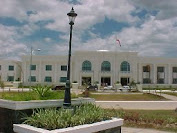Friday, January 15, 2010
Tuesday, March 18, 2008
Nueva Ecija
Posted by paw at 3:49 PM 0 comments
Labels: Nueva Ecija
History
Nueva Ecija was created as a military comandancia in 1777 by Governor General Clavería, with the capital at Baler (now part of Aurora). It was formerly part of the province of Pampanga. From its humble beginning, its land area grew to cover almost the entire island of Luzon. Spanish Records in the Philippines recognizes 2 Spanish countries in the Pacific-- Las Islas Filipinas and Nueva Ecija. Poverty was the only reason why Nueva Ecija was not given recognition as a separate country from the Philippines by the King of Spain in 1840s. From 1777 to 1917, Nueva Ecija's territory was however subdivided to give way to the creation of other provinces. The Province of Tayabas (now Aurora and Quezon) including Polillo Islands, the provinces of Palanan (now Isabela), Cagayan, the province of Nueva Vizcaya, the territory which became part of the Province of Quirino, and the province of Manila north of the province of Tondo in 1867, and the District of Morong (now Rizal) were among those created out of Nueva Ecija.
During World War II the Imperial Japanese Army entered the province and Nueva Ecija was taken in 1942. In February, 1942, under the leadership of Luis Taruc the Hukbalahap (Hukbo ng Bayan Laban sa Hapon-People's Army Against the Japanese) which was the military arm to the Communist Party of the Philippines, began to attack Japanese forces from the villages of Sitio, Bawit, Baryo, San lorenzo and Cabiao. Thousands of these Filipino guerillas would engage the Japanese in Nueva Ecija occupation of the Philippines. In 1945, American and Filipino forces liberated Nueva Ecija with Filipino guerillas continuing to harass the Japanese at every opportunity. On January 30, 1945 American Army Rangers, Alamo scouts and Filipino guerillas conducted a raid to liberate Allied civilians and prisioners of war in Cabanatuan, this was successful with over 516 rescued. By January 31, 1945, the liberated civilians and POWs reached Talavera, the rescue is commorated in Talavera.
The Province was named after the old city of Écija in Seville, Spain.
In 1896, Nueva Ecija became one of the first provinces to revolt against Spanish rule, and one of the provinces which declared its independence in 1898.
Posted by paw at 3:47 PM 0 comments
Labels: History of Nueva Ecija
Tourist Attractions
Nueva Ecija is the largest province and the biggest rice producer of Central Luzon, thus, often referred to as the “Rice Bowl of the Philippines.”
Among its main attractions is the Pantabangan River, the country’s first multi-purpose infrastructure, which stands today as a phenomenon in Filipino engineering feats. Another is the Pampanga river, cutting across a rich valley floor, famed for irrigation, the generation of hydroelectric power, and the mitigation of flood damage.
Nueva Ecija is also the agri-tourism pilot site in Central Luzon due to the presence of the Central Luzon State University in the province.
Its other worthwhile attractions include the Minalungao National Park, Rizal Hot Spring, Burburayok Springs and Pajanutic Falls, Barrio Puncan in the town of Carranglan, among others.
Posted by paw at 3:45 PM 0 comments
Municipalities
ALIAGA
BONGABON
CABIAO
CARRANGLAN
CUYAPO
GABALDON (Bitulok & Sabani)
GENERAL MAMERTO NATIVIDAD
GENERAL TINIO (Papaya)
GUIMBA
JAEN
LAUR
LICAB
LLANERA
LUPAO
NAMPICUAN
PANTABANGAN
PENARANDA
QUEZON
RIZAL
SAN ANTONIO
SAN ISIDRO
SAN LEONARDO
SANTA ROSA
SANTO DOMINGO
TALAVERA
TALUGTOG
ZARAGOZA
Posted by paw at 3:40 PM 0 comments
Labels: Municipalities of Nueva Ecija
Cities
Cabanatuan City
Gapan City
Palayan City
San Jose City
Science City of Munoz
Posted by paw at 3:34 PM 0 comments
Labels: Cities of Nueva Ecija
Political
The governor as of 2007 is Aurelio Matias Umali, who assumed his governatorial duties after winning the 2007 election.
The province is divided into four congressional districts which consists of 27 municipalities and 5 cities.
Posted by paw at 3:31 PM 0 comments
Labels: Political
Geography
Posted by paw at 3:29 PM 0 comments
Labels: Geography of Nueva Ecija
Major Industries
Nueva Ecija is one of the top producers of agricultural goods in the country. Its principal crops are rice, corn, and onion. The province is often referred to as the “Rice Granary of the Philippines.” Other major crops are mango, banana, eggplant, and garlic.
Fishponds are unevenly distributed throughout the province but the largest concentrations are in San Antonio, Sta. Rosa, and Cuyapo.
Several areas have mineral deposits. Copper and manganese have been found in Gen. Tinio, Caranglan, and Pantabangan. The upper reaches of Caranglan and Palayan are said to contain gold.
Posted by paw at 3:28 PM 0 comments
Labels: Major Industries of Nueva Ecija
Economy
Posted by paw at 3:26 PM 0 comments
Labels: Economy of Nueva Ecija




